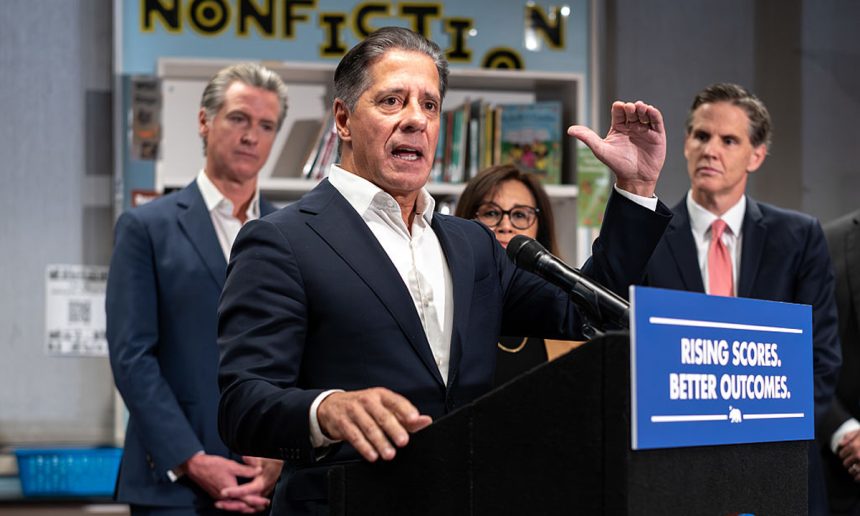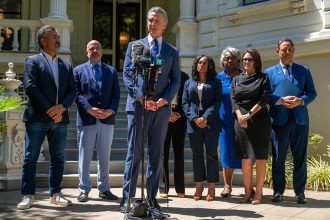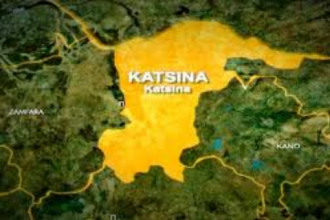GARDENA, Calif. — Two weeks into the new school year, Principal Sherree Lewis-DeVaughn eagerly showed off improvements to 135th Elementary School, where she’s been principal since 2022.
A painter prepped the side of a classroom building at the school for a new mural — smiling dragons in caps and gowns, and the district slogan: “Ready for the World.” On a patch of pavement sat a mini outdoor library featuring a small seating area, an umbrella for shade and a cart full of books.
She hopes the features prompt visitors to ask, “Who’s the principal here?” But the progress at 135th, part of the Los Angeles Unified School District, goes much deeper. Chronic absenteeism is down to 13%, from 17% in 2024. Over the past two years, the percentage of students meeting state standards in English language arts has climbed from 25% to 37%. In math, it grew from 26% to 34%.
Get stories like this delivered straight to your inbox. Sign up for The 74 Newsletter
The changes, along with the formation of a STEM lab and the addition of afterschool Boys and Girls Clubs, were enough to convince Daveyeon Shallowhorn, the school’s plant manager, to pull his two kids out of a nearby Catholic school and enroll them in 135th.
“I just see different things being offered that I don’t usually see,” he said.
Sherree Lewis-DeVaughn, principal of 135th Elementary in the Los Angeles Unified School District, showed how one classroom is implementing the i-Ready program, one of several changes Superintendent Alberto Carvalho has brought to the district. (Linda Jacobson/The 74)
Districtwide, leaders are celebrating the highest-ever performance on California’s state test. But the strong gains in math, reading and science, at every grade level, weren’t limited to wealthier, majority-white schools or high-performing magnets. They were evenly distributed across some of the district’s most challenging, high-poverty schools, like 135th.
Some say Superintendent Alberto Carvalho’s centralized approach to steering the nation’s second-largest district is lifting performance at schools that languished near the bottom for years. The seven-member school board, which hired him in 2021, reaffirmed their confidence in his leadership last month, voting unanimously to renew his contract for another four years. But others say there are likely multiple explanations for the boost. The question is whether the positive trends will continue in a city where the powerful teachers union has a history of resisting top-down programs.
“If Carvalho is seeing gains, that means our students are gaining,” said Jose Luis Navarro, a former principal in the district who now coaches school leaders. For now, United Teachers Los Angeles is unhappy that a recently adopted budget didn’t include raises. Nevertheless, Navarro urged the union to embrace Carvalho’s agenda. “You’ve already tried fighting every superintendent for the last 40 years. Just try working with one and see what happens.”
The improvements came in spite of wildfires that wiped out part of the city, a crackdown on undocumented students and a federal government trying to force its will on blue California.
“Our kids, our students persevered,” Carvalho, who declined to be interviewed, said at his back-to-school address in late July. “They, in fact, soared.”
But while students from all racial groups improved, significant gaps remain. At least two-thirds of white and 74% of Asian third-graders met or exceeded expectations in reading, compared to 37% of Latino students and 31% of Black students.
“We will redouble our efforts. We will redouble our commitment,” he pledged at an Oct. 10 press conference at Maywood Elementary.

Los Angeles Unified School District Superintendent Alberto Carvalho delivered his back-to-school address at Walt Disney Concert Hall July 22. (Myung J. Chun/Los Angeles Times via Getty Images)
‘Smaller numbers’
Experts say the recent achievement growth among the district’s neediest students is likely a cumulative effect of several initiatives, including a more uniform approach to instruction, extra help for kids who are the furthest behind and a concentrated focus on the most troubled schools.
But Carvalho has “generally good instincts about what works,” said Morgan Polikoff, an education professor at the University of Southern California. The district adopted a research-based literacy curriculum, has trained over 10,000 teachers in the science of reading and has spread some of those same approaches to math instruction. “It seems the district is investing in quality curriculum and supporting teachers to use it.”
As scores go up, however, enrollment continues to dwindle. Over the past five years. LAUSD has lost 80,000 students.
But that factor could be working in the district’s favor. That’s because for now, LAUSD, unlike other California districts, has delayed mass layoffs, leaving some schools with more staff per student.
“You already have built-in small group instruction with smaller numbers,” said Nery Paiz, principal of Glen Alta Elementary School, east of downtown. With an enrollment of about 100, his average class size is about 19 students, he said.
Research shows that such “pronounced” declines can sometimes lead to increases in test scores. Another analysis found that enrollment loss doesn’t immediately translate into funding cuts, freeing up more resources for schools in the short term. LAUSD’s $18.8 billion budget, adopted in June, increases spending for majority-Black schools, arts programs and support for LGBTQ students.
‘No secret sauce’
Some in the district say the uptick in scores would have happened without Carvalho, whom they dismiss as a slick media personality.
“We’re far enough away from the lockdowns that teachers have been able to recover, and students have been able to recover,” said Nicolle Fefferman, a veteran high school social studies teacher in the district. “There is no secret sauce to teaching.”
She helps lead an advocacy group, Parents Supporting Teachers, whose members are far less enamored with Carvalho than when he arrived in early 2022. The district’s failed experiment with a $6 million AI chatbot has drawn accusations of misspending. Officials discontinued use of the tool when the company went under. Others argue he waited too long to close schools during the fires, relying on guidelines that failed to account for multiple fires burning across the region and filling the air with hazardous smoke.
Some parents say students have too much screen time in school and are unhappy with Carvalho’s move to roll out an online program called i-Ready. To Fefferman, the digital lessons and assessments represent “overtesting,” which the teachers union has traditionally opposed. UTLA didn’t respond to requests for comment, but Maria Nichols, president of Associated Administrators of Los Angeles, the principals union, said i-Ready has created “friction” between school leaders and teachers who object to the program.
The increase in scores is worth celebrating, she said, but said it came “on the backs of the [principals] who are working 60 hour weeks.” Her union joined with UTLA and SEIU Local 99, which represents non-teaching employees, in protest outside schools Sept. 16. All three are currently in negotiations with the district over salaries and working conditions.

Members of Associated Administrators of Los Angeles protested at schools in September, along with United Teachers Los Angeles and SEIU 99. (Courtesy of Associated Administrators of Los Angeles)
Board President Scott Schmerelson, who has the union’s support, said such concerns are to be expected. It’s a “general rule” to complain about the superintendent “no matter what he says, no matter what he does,” he said. But he called the “grumbling” minimal.
He’s particularly enthusiastic about the district’s Black Student Achievement Plan, a $175 million initiative that provides schools serving Black students additional counselors, cultural activities and field trips. Former Superintendent Austin Beutner proposed the program in early 2021 to reduce achievement gaps. Under Carvalho, it continues to expand, in spite of challenges from conservative advocates who say it discriminates against students of other races.
Since last year, students in Black Student Achievement Plan schools have seen slightly more growth in reading and math than the district as a whole.
The additional resources have “helped [Black students] a lot, not only academically but emotionally,” Schmerelson said. “I think they feel important. I think they feel respected.”
$800 Million for CA Arts Ed & 7 Other Big School Propositions on Midterm Ballots
‘Nothing short of remarkable’
With high expectations, the board voted unanimously to hire Carvalho in late 2021. At the time, Pedro Noguera, dean of education at the University of Southern California, likened the award-winning superintendent’s arrival to“LeBron coming to the Lakers.” The board trusted that Carvalho’s success leading the Miami-Dade schools for 14 years would follow him to the West Coast.
But efforts to overcome COVID learning loss and rise above pre-pandemic performance began a year earlier, with schools still locked down. Most students wouldn’t set foot in classrooms for another year.
Beutner used COVID relief funds to launch Primary Promise, a highly popular effort to target extra instruction to struggling readers, including English learners, students in foster care and others most likely to fall further behind because of school closures.
In 2021, a Boston-based consulting group that designed the model called the results “nothing short of remarkable.” On average, students began the year reading five words correctly per minute. Some couldn’t read at all. After 10 weeks, they were close to reaching the goal of 21 words per minute.
Miami’s Carvalho Brings Rock Star Status to Top L.A. Schools Job
Julie Navarro, who is married to Jose, worked on the program as a reading specialist at Panorama City Elementary in the San Fernando Valley, where she said teachers were eager to share materials and ideas with each other.
“It was seriously the most positive collaboration I’ve ever been a part of,” she said. Primary Promise teachers attended monthly training that she described as “well-planned, thorough and research-based.”
Then Carvalho changed the model, arguing that with relief funds drying up, it was unsustainable to keep paying instructional aides to staff the program. The renamed Literacy and Numeracy Intervention expanded services into higher grades, drawing criticism from some educators who said the emphasis on the early grades was what made it effective. Beutner and Ray Cortines, also a former superintendent in the district, called the move a mistake.
LAUSD Moves Forward With Revamped Math and Reading Intervention Program
“I had never seen teachers who were willing to die on the hill of an LAUSD program,” Fefferman said. “As a high school teacher, I was like ‘Yes, please make sure they can read by third grade.’ ”
In Julie Navarro’s view, educators who lead the intervention work are sometimes “pulled in multiple directions” and the program has “less integrity” than the original. But Panorama, she said, is an example of staying true to the model of giving students small group instruction and consistently tracking their progress.
The school has seen double digit increases in reading and math since 2022 and was on this year’s list of California Distinguished Schools. With many families facing financial hardship and newcomers navigating language and cultural barriers, Julie described the population as “the most-challenged families I’ve ever seen all at one school. In spite of their situation, they were growing.”
‘Kids know their data’
Close attention to student data was a hallmark of the Primary Promise program. Carvalho expects the same level of monitoring districtwide with i-Ready. The platform, Schmerelson said, helps teachers know whether to “slow down” the pace of learning for students who are struggling or move kids ahead.
On a bulletin board in a second grade classroom at 135th Elementary, students’ initials are clustered into four color-coded groups — from blue for exceeding standards in i-Ready down to red for being two grade levels behind. Some argue that “data walls” can embarrass students if they’re not among the high-achievers. But Tanya Ortiz-Franklin, the school board member whose district includes the school, believes the practice motivates students to work hard.
“Kids know their data and teachers know their data,” she said. “They are using it to move instruction. That’s exactly what we’ve been trying to do for years.”

LAUSD Superintendent Alberto Carvalho and Board Member Tanya Ortiz Franklin talked with second graders last year during a Read Across America event. (Brittany Murray/MediaNews Group/Long Beach Press-Telegram via Getty Images)
Her region encompasses 175 schools that stretch from the Port of Los Angeles in San Pedro — the busiest container terminal in the U.S. — to the historic Black neighborhoods south of downtown. They include Maya Angelou Community High School, one of Carvalho’s 121 “priority schools,” where he takes a more hands-on approach to tracking data and staffing schools with extra counselors and academic coaches.
“I spend 90% of my time dealing with 10% of the schools,” Carvalho said at a conference at Harvard University in September. “They are accountable directly to me.”
The schools have some of the poorest achievement and attendance rates in the district, and in Maya Angelou’s case, a high rate of community violence. In 2019, the Los Angeles Times listed the high school among those with at least 50 homicides within a one-mile radius over a five-year period. In 2023, a stray bullet injured a staff member during a football game at the school.

Maya Angelou Community High School, one of Superintendent Alberto Carvalho’s priority schools, has seen gains in scores for the past two years. (Linda Jacobson/The 74)
“Being an inner-city school, it’s very easy to focus on the negative aspects that happen here. That’s the low hanging fruit,” said Principal Jose Meza. That’s why he encourages staff and students to “flood” social media platforms with positive news, like a poetry night for newcomers, and the 13 students admitted to Berkeley and the University of California Los Angeles this year.
“Embracing our roots and honoring our heritage,” the school posted on Instagram for Hispanic Heritage Month, with a reel of students dancing, sampling food and displaying artwork.
But in trying to make students feel welcome and safe inside the fence that surrounds the school, Meza has also tightened up the academic program. He reassigned counselors to students by grade level, rather than grouping them alphabetically. The change allows ninth graders to get extra support as they adjust to the demands of high school.
He gives students a double dose of Algebra I each day if they need it, and moved credit recovery courses to the regular school day instead of afterschool or on Saturdays when they’re less likely to come. His students have posted gains in state scores the past two years, but two-thirds of 11th graders still don’t meet expectations in language arts and over 80% are failing math.
“Half of our students are coming in below grade level,” he said “That doesn’t mean we’re going to treat them as such. We’re going to have expectations that are aligned to the standards.”
Carvalho aims to create more consistency in teaching across the district, but he’s choosing math and reading programs based on the experience of schools that tested programs and found them to be effective with high-need students, said Rick Miller, CEO of CORE Districts, a network of nine large systems in the state, including LAUSD.
Illustrative Math, now being phased in districtwide, is one example. Teachers at Jordan High School, in a densely populated neighborhood of housing projects and small homes, were among the first to use the program.

Students in an Advanced Placement Statistics at Jordan High School class practice problems to prepare for a test. The school used Illustrative Math before the Los Angeles Unified decided to roll it out districtwide. (Linda Jacobson/The 74)
On a Monday morning earlier this month, 10th graders in Luis Lopez’s geometry class opened their workbooks to a new lesson on congruent shapes. They chatted with classmates about the set of rectangles on the page before Lopez stepped in to remind them of vocabulary words like “vertices” and “corresponding.” The curriculum is structured so that students grapple with new concepts and work together on problems before teachers deliver a full lesson.
“When we were going to school, especially in math, it was ‘I will model. I’m the teacher and now … you’ll just do 100 problems,’ ” said Principal Alex Kim. This curriculum, he said, flips that process while also ensuring the tasks focus on grade-level material.
The program has gained popularity in other districts. The New York City Public Schools saw a decline in scores after implementing the curriculum in hundreds of schools. But two earlier studies, one in Missouri and one in Maryland, found that students using Illustrative Math outperformed those who didn’t. At Jordan, a quarter of 11th graders met expectations in math, compared to less than 4% two years ago.
Illustrative Math’s CEO on What Went Wrong in NYC and Why Pre-K Math Is Up Next
‘Historic generational implications’
To some former LAUSD parents, the improvements are too little, too late.
They are cynical about any post-pandemic rebound, saying that the district contributed to learning loss by staying closed almost until the end of the 2020–21 school year.
“I don’t think LAUSD should get credit for putting out a fire that it was responsible for lighting,” said Ben Austin, a longtime Democratic political adviser and former member of the state school board. “My daughters didn’t go to school for 18 months, along with all the other kids in LAUSD. That obviously had historic generational implications.”
California’s sluggish reopening affected students statewide, but what angered some LAUSD parents the most was the teachers union’s influence over remote instructional time during school closures. In March 2021, The 74 reported that the union negotiated a reduced, six-hour school day despite district officials saying they didn’t want to “shortchange the students.” The revelation came during a lawsuit, finally settled last month, against the district and the union.
Court Documents Reveal How L.A. Teachers Union Gained Upper Hand in Pandemic Negotiations, Limiting Instruction Time
The agreement promises 45 hours per year of high-dosage tutoring to 100,000 students who are the furthest behind as well as summer school for up to 250,000 students in the district who were affected by the extended closures.
During the 2020-21 school year, Judith Larson said her daughter’s remote classes often “ended well before they were supposed to” or that teachers used the sessions to collect homework assignments rather than provide live instruction. Her daughter lost so much ground in math that last year, as a junior in high school, she scored at a sixth grade level. In English, she was two years behind and losing hope that she would be able to attend the University of California Los Angeles, her dream school. Now a senior, she’s made progress, but still struggles in math.
“She is working hard to bridge the gap,” her mother said. “I am hoping that the high-dose tutoring … will help her get there.”
As with schools nationwide, the pandemic worsened longstanding achievement gaps in LAUSD. There’s still a 30 percentage point difference between poor students and those from wealthier families in reading and math.
“There’s a long way to go,” and “with each year, progress gets harder,” Miller said. But as a former state education official, he never expected LAUSD to outperform the state. “They were too big.”

LAUSD Superintendent Alberto Carvalho, joined by state Superintendent Tony Thurmond, far right, spoke at Maywood Elementary to announce the latest state test scores. (Linda Jacobson/The 74)
This year, LAUSD’s growth exceeded the state’s and California’s other large school districts. During the press event at Maywood Elementary, state Superintendent Tony Thurmond was on hand to mark the achievement. He organized a webinar so other districts in the state could “hear some of the stories about what has created that success.”
Speaker after speaker stepped to the podium to share in what one board member called a “watershed moment” for LAUSD. Drawing a few chuckles, Carvalho paused to note that Thurmond had to slip out early and “give some love to other lower-performing districts.”









